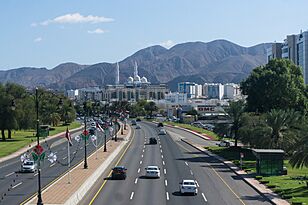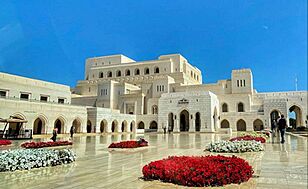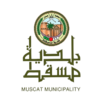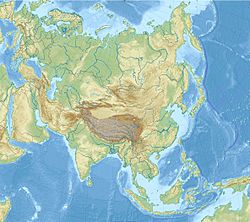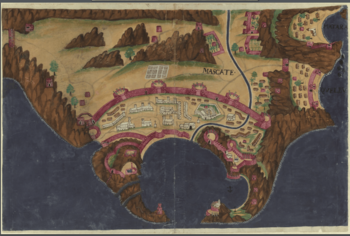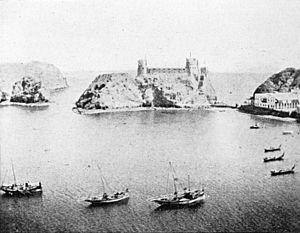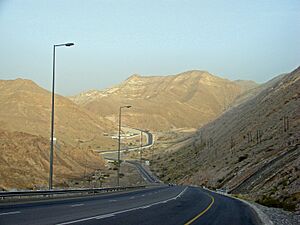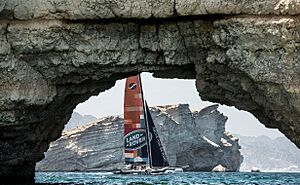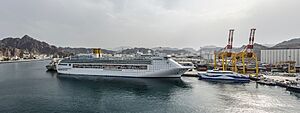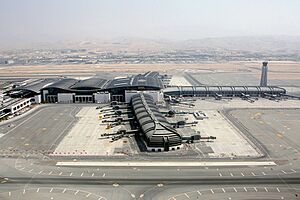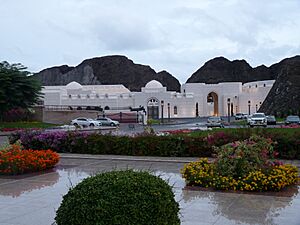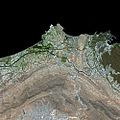Muscat facts for kids
Quick facts for kids
Muscat
مَسْقَط
|
|||
|---|---|---|---|
|
Capital city and Metropolis
|
|||
|
Clockwise from top: Muttrah; Al Alam Palace; Royal Opera House Muscat; Sultan Qaboos Grand Mosque; Sultan Qaboos Street;
|
|||
|
|||
| Nickname(s):
The Pearl of Arabia
|
|||
| Country | |||
| Governorate | Muscat Governorate | ||
| Government | |||
| • Type | Absolute monarchy | ||
| Area | |||
| • Land | 3,500 km2 (1,400 sq mi) | ||
| • Metro | 3,797 km2 (1,466 sq mi) | ||
| Population
(2023)
|
1,720,000 (Urban Area) 31,409 (Old Muscat Wilayat) |
||
| • Density | 491/km2 (1,270/sq mi) | ||
| • Metro | 1,720,000 | ||
| Time zone | UTC+4 (GST) | ||
Muscat (Arabic: مَسْقَط, Masqaṭ) is the capital and largest city in Oman. It's where the government of the Muscat Governorate is located. In September 2022, about 1.72 million people lived in the Muscat area. This large city covers about 3,500 square kilometers and includes six provinces called wilayats. This makes it the biggest city in the Arabian Peninsula by land area.
Muscat has been an important trading port since the early 1st century AD. It connected the West with the East. Over time, different groups ruled Muscat, including the Persians, the Portuguese Empire, and the Ottoman Empire. In the 1700s, Muscat was a strong military power in the region. Its influence reached as far as East Africa and Zanzibar.
Because it was a key port in the Gulf of Oman, Muscat attracted traders and settlers from other places. These included people from Persia, Balochistan, and Sindh. Since Qaboos bin Said became the Sultan of Oman in 1970, Muscat has grown very quickly. It now has a strong economy and a diverse society with people from many backgrounds. Muscat is considered a "Beta Global City" by a group that studies world cities.
The Hajar Mountains are a big part of Muscat's landscape. The city sits on the Arabian Sea along the Gulf of Oman. It is also close to the important Straits of Hormuz. Most buildings in Muscat are low and white. The port area of Muttrah, with its waterfront (corniche) and harbor, is in the northeastern part of the city. Muscat's economy mainly relies on trade, oil, natural gas, and shipping.
Contents
What's in a Name?
Historians have different ideas about where the name Muscat comes from. Ancient maps mention places like Cryptus Portus and Moscha Portus. Some scholars think one of these names refers to Muscat. Others believe the name Muscat comes from an Arabic word meaning "anchorage" or "a place to drop anchor." Some also think it might come from an old Persian word meaning "strong-scented," or another Arabic word meaning "falling-place" or "hidden." People from Muscat are sometimes called Muscatter or Muscatian. In 1793 AD, Muscat became the capital of Oman, taking over from Rustaq.
Muscat's Long History
People have lived in the Muscat area for a very long time. Evidence shows activity from as far back as 6,000 BC. Burial sites of fishermen have been found, showing that people had special rituals. Pottery from the Indus Valley civilisation found south of Muscat suggests trade with ancient India.
The Greek geographer Ptolemy knew Muscat as an important port in the 1st century AD. He called it Cryptus Portus, meaning "the Hidden Port." Another writer, Pliny the Elder, called it Amithoscuta.
In the 3rd century AD, the Sassanids took over the port. Later, in the 7th century, the area became Islamic. Muscat continued to grow as a trading port under local tribes. In the 9th century, the first Imamate was formed, uniting Omani tribes. However, conflicts continued, and the Abbasids from Baghdad conquered Oman. They ruled until the 11th century.
Later, the Portuguese arrived in 1507. Admiral Afonso de Albuquerque tried to set up trade, but his ships were attacked. He then decided to conquer Muscat, and much of the city was burned.
The Portuguese held Muscat for over 100 years. They faced challenges from Persia and even bombardments by the Ottoman Turks. The Turks captured Muscat twice, in 1552 and from 1581–88. In 1624, Nasir bin Murshid Al-Ya'rubi became Imam of Oman. This shifted power from the Portuguese back to the Omanis. The Al Jalali Fort and the Al-Mirani Fort are two important castles built by the Portuguese. In 1648, the Imam's army attacked Muscat, weakening the Portuguese. Finally, on January 23, 1650, the Imam's troops forced the Portuguese to surrender.
Later, in the 18th century, civil wars and invasions by the Persian king Nader Shah made the region unstable. This led to the rise of the Al Bu Sa'id Dynasty, which still rules Oman today.
In the 19th century, Muscat's power at sea grew again under Said bin Sultan. He signed a treaty with the U.S. in 1833. Said also gained control of Zanzibar and even moved his capital there in 1840. But after he died in 1856, Zanzibar became a separate sultanate.
By the 1800s, a large community of Hindu merchants played a big role in Muscat's trade. They had been settling there since at least the 1400s. They even helped to remove the Europeans in 1650. These merchants continued to do well under the new Omani rulers. Trade was strong between Muscat and parts of India.
In the late 19th and early 20th centuries, there were conflicts between Muscat and tribes from the interior of Oman. The British helped arrange a ceasefire, giving the interior more freedom. However, conflicts continued, leading to the Dhofar Rebellion in the 1960s. Sultan Said bin Taimur had to ask the British for help. After an attempt on his life in 1966, the Sultan became more isolated.
On July 23, 1970, his son, Qaboos bin Said, took over as ruler in a peaceful change of power.
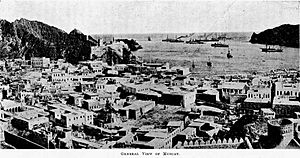
With British help, Sultan Qaboos ended the Dhofar uprising and united the different tribal areas. He renamed the country the Sultanate of Oman to bring the interior and Muscat closer. Qaboos brought in skilled Omanis to work in his new government. New government departments for health and education were created.
Important projects like the new Mina Qaboos port and a new international airport in the Seeb area of Muscat were developed. An old village called Ruwi became a busy commercial area with offices, shops, and homes. The first five-year development plan in 1976 focused on building up Muscat's infrastructure. This brought new chances for trade and tourism in the 1980s and 1990s, attracting people from all over the region. In June 2007, Cyclone Gonu hit Muscat, causing a lot of damage to buildings and roads.
Muscat's Location and Landscape
Muscat is in northeast Oman. It is bordered by flat plains to the west and other regions to the east and south. The Gulf of Oman is to the north and west. The water along Muscat's coast is deep, forming two natural harbors in Muttrah and Muscat. The Central Hajar Mountains run along the northern coast of the city.
The hills and mountains around Muscat are made of volcanic rocks. These rocks are common along the Gulf of Oman coast. South of Muscat, the volcanic rocks are broken and twisted, reaching heights of up to 1,800 meters (6,000 feet) in the Al-Dakhiliyah area. The hills in Muscat don't have much plant life but are rich in iron.
Muscat has special desert plants that can grow in salty soil. The Qurum Nature Reserve has plants like Arthrocnemum Macrostachyum. Coral reefs are also common in Muscat's waters. Crabs, spiny crayfish, sardines, and bonito fish live in the sea around Muscat. Small fish called glassfish are found in freshwater areas like the Qurum Nature Reserve.
Sultan Qaboos Street is the main road in Muscat, running from west to east. It connects to other major roads. Muttrah, with its harbor and waterfront, is on the northeastern coast. Other coastal areas include Darsait, Mina Al Fahal, and Al Seeb. Inland areas include Ruwi, Madinat Qaboos, and Al Ghubra.
Muscat's Climate
Muscat has a very hot and dry climate. Summers are long and extremely hot, while winters are warm. It doesn't rain much in Muscat, usually about 10 centimeters (4 inches) per year. Most of the rain falls from December to April. From May to November, there's usually only a tiny bit of rain.
However, sometimes strong tropical storms from the Arabian Sea hit the city. For example, Cyclone Gonu in June 2007 and Cyclone Phet in June 2010 brought strong winds and over 100 millimeters (4 inches) of rain in just one day. In summer, the weather is very hot and also very humid, with temperatures sometimes reaching 45°C (113°F).
| Climate data for Muscat | |||||||||||||
|---|---|---|---|---|---|---|---|---|---|---|---|---|---|
| Month | Jan | Feb | Mar | Apr | May | Jun | Jul | Aug | Sep | Oct | Nov | Dec | Year |
| Record high °C (°F) | 34.6 (94.3) |
38.2 (100.8) |
41.5 (106.7) |
44.9 (112.8) |
48.3 (118.9) |
48.5 (119.3) |
49.1 (120.4) |
49.2 (120.6) |
47.2 (117.0) |
43.6 (110.5) |
39.4 (102.9) |
37.8 (100.0) |
49.2 (120.6) |
| Mean daily maximum °C (°F) | 25.5 (77.9) |
26.1 (79.0) |
29.8 (85.6) |
34.7 (94.5) |
39.5 (103.1) |
40.4 (104.7) |
38.6 (101.5) |
36.2 (97.2) |
36.3 (97.3) |
35.0 (95.0) |
30.5 (86.9) |
27.1 (80.8) |
33.3 (92.0) |
| Daily mean °C (°F) | 21.3 (70.3) |
21.9 (71.4) |
25.2 (77.4) |
29.8 (85.6) |
34.2 (93.6) |
35.2 (95.4) |
34.3 (93.7) |
32.0 (89.6) |
31.4 (88.5) |
29.7 (85.5) |
25.7 (78.3) |
22.6 (72.7) |
28.6 (83.5) |
| Mean daily minimum °C (°F) | 17.3 (63.1) |
17.6 (63.7) |
20.7 (69.3) |
24.7 (76.5) |
29.1 (84.4) |
30.6 (87.1) |
30.4 (86.7) |
28.4 (83.1) |
27.5 (81.5) |
24.9 (76.8) |
20.9 (69.6) |
18.9 (66.0) |
24.3 (75.7) |
| Record low °C (°F) | 1.6 (34.9) |
2.3 (36.1) |
7.0 (44.6) |
10.3 (50.5) |
17.2 (63.0) |
21.6 (70.9) |
23.5 (74.3) |
21.3 (70.3) |
19.0 (66.2) |
14.3 (57.7) |
9.4 (48.9) |
4.5 (40.1) |
1.6 (34.9) |
| Average precipitation mm (inches) | 12.8 (0.50) |
24.5 (0.96) |
15.9 (0.63) |
17.1 (0.67) |
7.0 (0.28) |
0.9 (0.04) |
0.2 (0.01) |
0.8 (0.03) |
0.0 (0.0) |
1.0 (0.04) |
6.8 (0.27) |
13.3 (0.52) |
100.3 (3.95) |
| Average relative humidity (%) | 63 | 64 | 58 | 45 | 42 | 49 | 60 | 67 | 63 | 55 | 60 | 65 | 58 |
| Mean monthly sunshine hours | 268.6 | 244.8 | 278.3 | 292.5 | 347.4 | 325.7 | 277.7 | 278.6 | 303.9 | 316.9 | 291.9 | 267.0 | 3,493.3 |
| Source: NOAA (1961–1990) | |||||||||||||
Muscat's Economy
Muscat's economy, like the rest of Oman, is mostly based on trade. In the past, the city exported things like dates, mother of pearl, and fish. Many of the traditional markets (souks) in Muttrah still sell these items and Omani crafts.
Petroleum Development Oman (PDO) has been very important to Muscat's economy since 1962. It's the country's second-largest employer after the government. PDO produces a lot of oil every day. Muscat also has big trading companies that partner with famous international brands.
The Muscat Securities Market is Oman's main stock exchange. It was started in 1988 and is known for being open and clear about its rules.
Mina'a Sultan Qaboos, Muscat's main trading port, is a key hub for trade between the Persian Gulf, India, and the Far East. It handles millions of tons of cargo each year. However, the Jebel Ali Free Zone in nearby Dubai has become an even bigger port in the region.
The Omani government owns and runs many of the city's important facilities. Omantel is the main phone company in Oman and the only internet provider. Recently, another mobile phone company, Ooredoo, has also started operating.
Who Lives in Muscat?
In 2003, Muscat had over 630,000 people. About 60% of them were Omanis, and 40% were people from other countries. Muscat was the second-largest region in Oman by population.
The Muscat area includes six provinces: Muttrah, Bawshar, Seeb, Al Amrat, Muscat, and Qurayyat. Seeb, in the west, had the most people. Muttrah had the most people from other countries. Most of Muscat's population (about 71%) was between 15 and 64 years old. The average age for Omanis was 23.
Most people in Muscat can read and write. People from other countries make up over 60% of the workers, mostly men. Many work in engineering, office jobs, or science. The defense sector is the biggest employer for Omanis. Construction and trade employ the most people from other countries.
Muscat's population has always been influenced by people from outside the Arabian Peninsula. In the 1800s, many Hindu merchants from India lived there. There were even Hindu temples in Muscat around 1760. Christianity was present in Oman from the late 300s to the 600s. It was brought back by the Portuguese in 1507.
Like the rest of Oman, Arabic is the main language spoken in Muscat. However, many other languages are also spoken by residents. These include English, Balochi, Sindhi, Swahili, and several Indian languages like Hindi, Malayalam, and Urdu.
Islam is the main religion in Muscat, with most followers being Ibadi Muslims. People of other religions are allowed to practice their faith. However, they cannot try to convert others publicly or give out religious books. In 2017, Oman created the Mushaf Muscat, an interactive version of the Quran.
Places to See in Muscat
Muscat has many mosques, including the beautiful Sultan Qaboos Grand Mosque, Ruwi Mosque, and Zawawi Mosque. There are also a few Shi'ite mosques. The city is home to several museums, such as the National Museum of Oman, Oman Children's Museum, and Sultan's Armed Forces Museum. The Bait Al Falaj Fort was important in Muscat's military history.
New projects include the Royal Opera House Muscat, which opened in 2011. The Oman National Museum is another notable new building. Visitors can also explore Old Muscat and the Old Palace.
The main shopping area is in Al Qurum Commercial Area. However, you can find shopping malls all over the city. Some of the biggest malls in Oman are Oman Avenues Mall in Ghubra, and City Centre Muscat in Seeb, near the airport. Two newer large malls, Al Araimi Boulevard and Mall of Muscat, opened in 2019 and 2020. The Mall of Muscat also has the Oman Aquarium. The Mall Of Oman, the largest mall in Oman, opened in 2021. It has many stores, a snow park, cinemas, and food places.
Getting Around Muscat
Water Transportation
Port Sultan Qaboos is one of the most important ports in Muscat. Many commercial ships and traditional Arabian boats called Dhows can be seen here. For centuries, this port has been a major center for international trade.
Air Transportation
The main airport is Muscat International Airport (formerly Seeb International Airport). It's about 25 kilometers (15 miles) from the business district of Ruwi. Muscat is the main base for Oman Air, which flies to many places in the Middle East, India, East Africa, and Europe.
Road Transportation
Muscat has good paved roads, and highways connect most major cities and towns in Oman.
Since November 2015, public transportation in Muscat has improved a lot. There's a bus network connecting most parts of the city with modern Mwasalat buses. These buses have cool features like free Wi-Fi.
- Route 1 (Ruwi-Mabela) goes to major shopping malls and Muscat Airport.
- Route 2 (Ruwi-Wadi Kabir) serves a residential and industrial area.
- Route 3 (Ruwi-Wadi Adei) serves a residential area.
- Route 4 (Ruwi-Mattrah) goes to tourist spots like Muttrah Corniche and the National Museum.
- Route 5 (Ruwi-Amerat) serves a fast-growing suburb.
- Route 6 (Ruwi-SQU&KOM) serves students at Sultan Qaboos University and people working at Knowledge Oasis Muscat.
- Route 7 serves three major malls.
- Route 8 serves Al Khuwair and Al Mouj.
- Route 9 serves industrial areas.
- Route 10 serves the Seeb Souq and Mawelah Vegetable Market.
- Route 12 serves the Oman Convention and Exhibition Centre.
- Route 14 serves Petroleum Development Oman and Qurm Natural Park.
- Routes 1b and 1A are special buses to Muscat International Airport.
Other popular ways to get around in Oman include "Baiza" buses. These are cheap and go on most major roads, picking up and dropping off passengers anywhere. There are also larger public buses that travel between major cities. Taxis, which are orange and white, offer rides for individuals or can pick up multiple passengers along the road.
Taxi fares are usually negotiated, as there are no meters. It's a good idea to ask your hotel or host what the normal fare is for your trip before you get into a taxi. Taxis can also take you to cities outside Muscat, like Sohar or even Dubai.
Muscat's Culture
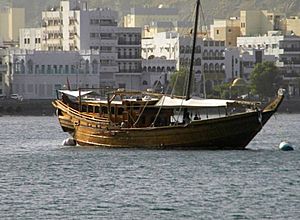
Oman shares many cultural features with its Arab neighbors, especially those in the Gulf Cooperation Council. However, Oman also has unique qualities due to its geography, history, and culture. Oman's culture is more diverse than some other Arab countries because of its historical connections to the Swahili Coast and the Indian Ocean.
Oman has a long history of shipbuilding. Traveling by sea was very important for Omanis to connect with ancient civilizations. Sur was a famous shipbuilding city. The Al Ghanja ship, for example, takes a whole year to build. Other types of Omani ships include the As Sunbouq and Al Badan.
In 2016, archaeologists found a shipwreck near Al-Hallaniyah Island. They believe it's the Esmeralda from Vasco da Gama's fleet from 1502–1503. The ship was identified by items like a rare Portuguese coin and stone cannonballs with the initials of Vincente Sodré, who was a commander in da Gama's fleet.
Notable People from Muscat
- Mohammed Al Barwani (born 1952), a billionaire who started MB Holding.
- Mahesh Bhupathi (born 1974), an Indian tennis player who studied in Muscat.
- Sarah-Jane Dias (born 1974), an Indian actress who studied in Muscat.
- Isla Fisher (born 1976), an Australian actress.
- Tate McRae (born 2003), a Canadian singer-songwriter who studied in Muscat.
- Ali Al-Habsi (born 1981), a professional footballer and captain of the Oman national team.
- Ahmad Al Harthy (born 1981), a racecar driver.
- Fatma Al-Nabhani (born 1991), a tennis player.
- Sneha Ullal (born 1987), an Indian Bollywood Actress who studied in Muscat.
- Al Faisal Al Zubair (born 1998), a racecar driver.
- Muzna Al Musafer (born 1987), Oman's first female film director.
Images for kids
See also
 In Spanish: Mascate para niños
In Spanish: Mascate para niños


